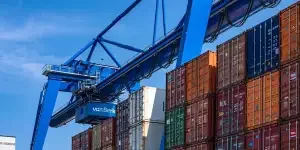As ecommerce brands push through the last of their holiday sales, and set a strategy for 2025, many businesses will take an in depth look at their shipping mix. Below are the major current changes in the shipping industry, their impact, and predictions on what next year will bring.
The topline advice for ecommerce brands looking ahead:
- Diversify your carrier portfolio to make use of the right carriers for your product and brand. This may mean looking outside of the major US conglomerates, and toward regional carriers.
- Partner with reliable external partners for support and cost-savings. A 3PL, for example, should have an efficient combination of volume discounts with vetted carriers, and state-of-the-art shipping technology to optimize and find the best service.
1. Changes at the USPS—will it favor the private sector in the long run?
One of the biggest disruptions in ecommerce shipping is what the USPS is doing to take over a greater share of the sortation and management of parcel shipping, and how it is affecting their long-standing partnerships with private entity hybrid carriers. Buckle up, this one’s layered.
The Current Situation:
The United States Post Office continues to make moves to take over more than just the last-mile delivery of parcel shipping. Part of this shift started in 2023 with the introduction of USPS Ground Advantage, a complete service that the consolidators don’t participate in.
Consolidator carriers are those that do the pickup, sortation, and distribution of packages but hand them off to USPS for the last-mile delivery. DHLeCommerce, OSM Worldwide and UPS Surepost are examples of this; their services are efficient and cost-effective, and used for many ecommerce deliveries. You can learn more about hybrid carriers and how they operate here.
The USPS is now forcing consolidators to deposit parcels further upstream in their network, giving the Postal Service a higher volume of parcels for more of the delivery journey. It’s not clear if the intent is to eliminate the consolidators all together or marginalize them at best.
What’s Changing:
Earlier in 2024 the USPS made these following service-level changes.
- Elimination of the ounce-based pricing for parcels that weighed under a pound.
- Elimination of the discount that the consolidator carriers got for handing off parcels at post offices for USPS to complete the final delivery.
This means that lightweight parcels will now be placed at a higher level within the cost structure. Shippers will likely have to raise service prices to accommodate higher shipping fees. Some hybrid carriers may offer ounce-based pricing, but it will be on their own terms, and they may simplify it to their own benefit.
The Impact:
Impact on shippers and consumers
Where the impact will be felt most will be consumers, as brands will likely pass additional shipping costs directly to customers. Transit times may also increase, customers might not get packages as quickly.
Impact on the shipping market
The real impact of the elimination of ounce-based pricing is yet to be revealed. Most service agreements that USPS holds with consolidators are still in effect and have yet to be renegotiated.
- These pricing changes will be in future NSAs (Negotiated Service Agreements) that will be rolled out this coming year.
- Some of the hybrid carriers have signed new NSAs with the USPS but for a much shorter time than they traditionally had—a one-year deal, instead of a three-year deal.
- Other carriers are opting for a non-exclusive agreement with the Postal Service, which means they don’t have to ship exclusively with the USPS but give portions of their volume to other carriers. In many cases volume will go to regional carriers instead of the USPS.
Predicted Outcome:
While it appears the intent of the Postal Service is to take over a greater piece of the shipping puzzle under their roof, and pull more of that money in, the market may shift in a way that favors the private sector. These choices, and others, may drive hybrid carriers to form partnerships with entities outside of the Postal Service, including regional carriers, taking money away from the USPS all together.
2. The Rise of Regional Carriers—how will it affect shippers and carriers?
There’s been a rise in regional carriers in the past few years, which may have an impact on the carrier market—with smaller carriers growing and forming partnerships, over time shippers will have a more diverse range of reliable carriers.
The Current Situation:
Some smaller tier carriers serving only a specific region of the US have shown significant growth in recent years. OnTrac is a great example. Having been around for a long time, OnTrac started to grow pre-2020, and then gained accelerated momentum through the pandemic. They were acquired by LaserShip and now the company reaches close to 80% of the US population.
What’s Changing:
As regional carriers continue to emerge and successful partnerships (like OnTrac) develop, the lower-tier carriers will start to evolve and grow to compete with the national conglomerate carriers. Naturally, some regional carriers will fail, and some will thrive, but the competition will be felt by larger carriers, giving shippers a more diverse range of shipping options.
Impact:
The value of this shift will be in the hands of shippers who can identify these rising carriers and efficiently integrate into their network. Success will come from choosing the regional carriers that help improve your overall shipping program.
Predicted outcome:
Not all regional carriers will take the path that OnTrac/LaserShip did. There are growing regions all over the US—the Midwest, Texas, Montana, the East Coast—where carriers are being bound together by technology partners in a way that’s creating a network. This is a partnership that looks different than a traditional acquisition or internal growth.
The advent of technology is playing an interesting role in being able to put a patchwork of careers together much more easily and efficiently than has been done in the past. We will see different types of growth that support or mimic the distribution and efficiency we’ve come to know with the larger conglomerate carriers.
The carrier landscape is a very intense and competitive market. It’s also saturated; many regional carriers will fail. It will be prudent to remain cautious about selecting which carriers are in your portfolio.
3. International Shipping—when will it be as seamless as domestic?
As the global ecommerce market continues to expand across borders, shippers will need reliable, streamlined, and tech-forward solutions that help organize and execute smooth international shipping.From pick-ups and sortation to customs clearance, cross-border shipping is a complex and often overwhelming process. However, mastering it is essential for brands looking to unlock access to global markets.
The Current Situation:
For any US shipper, an obviously large portion of their shipping and transportation needs to be focused on domestic shipping. But there are a lot of other countries that are very attainable.
The hurdles for brands expanding abroad are often regulatory compliance with different entities in the country. This is particularly true for health and wellness products, like nutritional supplements. The necessary approvals by different health entities across the world can vary, which can be complex.
In addition, the resources it takes to launch into a new country with a myriad of foreign carriers becomes resource heavy and hard to scale across not just one country, but many.
What’s Changing:
The international carrier landscape is growing to accommodate ecommerce expansion across the globe.
International shipping technology is becoming more adept, and providers are able to charge less of a premium for their services. With the rise of tech-enabled international shipping players, it is becoming easier to have a seamless end-to-end solution across not just one country, but multiple.
But international providers range widely. Some are tech-only, some easily handle direct-to-consumer shipments, and others focus on B2B shipments.
Impact:
With international shipping, there’s much more regulatory complexity to consider. So contrary to domestic shipping where it is beneficial to break up shipments across a multitude of carriers, international shipping is better done with a narrower number of carriers.
Selecting for reliability is also key as they handle the tax and duties aspects of your business and the harmonization and all the documentation.
Predicted Outcome:
The carriers to watch are the ones that can effectively handle both D2C and B2B well, to minimize the carrier pool that you need to use and have a strong tech component to give you a competitive edge.
There are many important aspects to international shipping that can make it seem daunting. They are all easy bridges to cross, but the key to unlocking your international shipping very profitable is finding the right partner who can make it a seamless expansion for you.
Having a partner who is highly experienced and knowledgeable in all aspects of regulatory compliance will pay off. This should go beyond simply applying a label, transmitting data, and handing off shipments for a fee. True expertise is the real the value-add. Otherwise, shipments can be denied entry into the country because the proper documentation is not in place.
Source from DCL Logistics
Disclaimer: The information set forth above is provided by dclcorp.com independently of Alibaba.com. Alibaba.com makes no representation and warranties as to the quality and reliability of the seller and products. Alibaba.com expressly disclaims any liability for breaches pertaining to the copyright of content.



